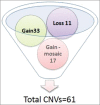Application of Chromosomal Microarray for Evaluation of Idiopathic Short Stature in Asian Indian Children: A Pilot Study
- PMID: 29535946
- PMCID: PMC5838887
- DOI: 10.4103/ijem.IJEM_202_17
Application of Chromosomal Microarray for Evaluation of Idiopathic Short Stature in Asian Indian Children: A Pilot Study
Abstract
Background: Human height is a classic polygenic trait and currently available data explains only 10% of the phenotypic variation in height. Almost 60%-80% of the children coming to pediatric and endocrinology outpatient department for the evaluation of short stature are still labeled as idiopathic.
Objectives: The aim of this study is to identify various chromosomal alterations causing idiopathic short stature (ISS) and short stature with dysmorphic features not pertaining to known genetic syndromes.
Materials and methods: After exclusion of all nutritional, systemic, endocrine, and syndromic causes of short stature, 19 patients with height <2 standard deviation scores were subjected to chromosomal microarray (CMA) study using Affymetrix CytoScan 750K array and CMA Scanner 3000 platform.
Results: We identified total 61 copy-number variant (CNV) and polymorphs (33 gains, 11 loss, and 17 gain-mosaics) not described as normal variants in database of genomic variations. We identified SHOX haploinsufficiency as a cause of short stature in two patients, whereas one patient was gain-mosaic for SHOX. All three had normal conventional karyotype. One of these patients also had deletion of PAX3, which could be the cause of both short stature and associated mild intellectual impairment in this patient. We also found a long noncoding RNA, namely, KIAA0125 and a pseudogene ADAM6 in 18 out of our 19 patients which might have a regulatory role.
Conclusion: This study shows that CMA is a very promising tool for the identification of pathogenic CNVs in patients with ISS. It can also help to identify novel genes controlling height and can open up new insight into pathophysiologic mechanisms underlying ISS, and thus may help to unfold new therapeutic targets for treatment of this condition. The association of CNV having genes for long noncoding RNAs, such as KIAA0125 and pseudogene such as ADAM6 with ISS suggest that they may play a role in controlling the expression of height-related genes and it needs further investigations.
Keywords: Chromosomal microarray; copy-number variations; idiopathic short stature.
Conflict of interest statement
There are no conflicts of interest.
Figures
References
-
- Visscher PM, Hill WG, Wray NR. Heritability in the genomics era – Concepts and misconceptions. Nat Rev Genet. 2008;9:255–66. - PubMed
-
- Ranke MB. Towards a consensus on the definition of idiopathic short stature. Horm Res. 1996;45(Suppl 2):64–6. - PubMed
-
- Lindsay R, Feldkamp M, Harris D, Robertson J, Rallison M. Utah Growth Study: Growth standards and the prevalence of growth hormone deficiency. J Pediatr. 1994;125:29–35. - PubMed
-
- Wit JM, Clayton PE, Rogol AD, Savage MO, Saenger PH, Cohen P, et al. Idiopathic short stature: Definition, epidemiology, and diagnostic evaluation. Growth Horm IGF Res. 2008;18:89–110. - PubMed
LinkOut - more resources
Full Text Sources
Other Literature Sources




